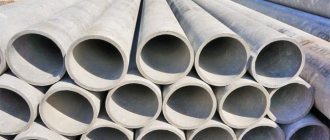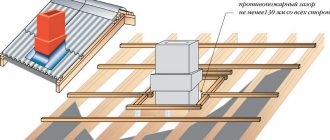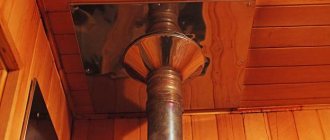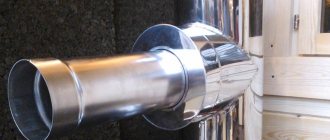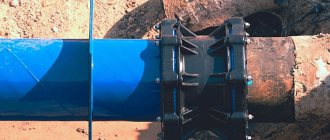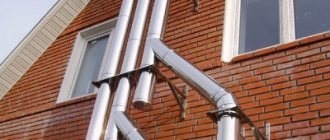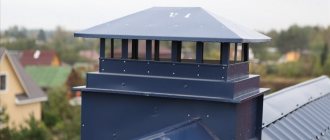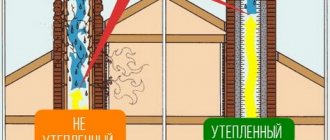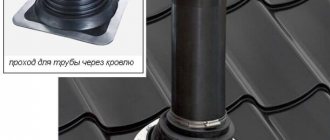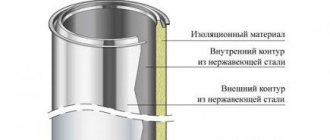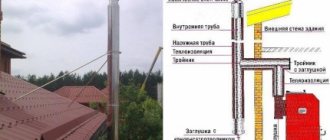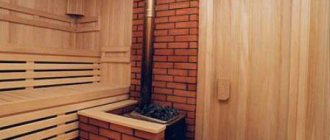Principle of operation
The principle of operation of chimneys is based on the phenomenon of expansion of hot gases, reducing their density and, accordingly, the rise of lighter gases upward.
Flue gases rise upward, a vacuum is formed in the firebox and colder air is sucked in - a draft phenomenon occurs.
Plastic chimneys
Advantages
- A lightweight plastic chimney for the home, inexpensive but flexible, does not rust and is quickly installed.
Plastic chimneys for condensing boilers
- For water heating boilers, liquid fuel or gas furnaces with exhaust gases up to + 120 degrees, the best option is to install plastic chimneys.
- The unique resistance to wear and condensation of chimneys made of high-tech polyvinylidene fluoride or polypropylene are the main advantages of this choice.
- A plastic chimney pipe for the home is easily cut with a saw and connected with ordinary push-on couplings.
Disadvantage: since such innovative chimneys have not yet gained much popularity, the range of pipes and parts is still small.
Regulatory requirements for the installation of chimneys
The main and only purpose of the chimney pipe is to remove waste gases from the heating boiler into the atmosphere outside the building where the stove, boiler or fireplace is installed. Moreover, the efficiency of heat-generating equipment directly depends on its correct installation.
You can install a boiler with excellent efficiency in your house, but make mistakes when installing the chimney pipe. The result is excessive fuel consumption and lack of comfortable air temperatures in the rooms. The chimney must have the correct cross-section, location, configuration and height.
If there are two boilers in the house or a stove and a fireplace in different rooms, then it is better to make separate smoke exhaust pipes for each of them. The option with one chimney is permitted by SNiPs, but only a professional stove maker can calculate it correctly.
The diameter of the chimney is selected depending on the heating equipment used. When installing the boiler, it is already specified by the manufacturer with the outlet pipe. It is prohibited to connect pipes of a smaller cross-section to it, and there is simply no need for a larger cross-section. In the second case, to increase traction, you will have to install a gearbox, which costs a lot of money.
In the case of a fireplace or Russian brick stove, everything is somewhat more complicated. Here you will have to make engineering calculations taking into account the fuel used and the size of the firebox. It is much easier to take a ready-made brick oven project that has been tested by time. Fortunately, there are many options with a clearly verified order of brickwork.
The height of the chimney pipe above the roof is determined by its distance from the roof ridge
The higher and longer the chimney, the stronger the draft. However, this can lead to overheating and destruction of its walls. Plus, a strong increase in draft is a prerequisite for the occurrence of turbulence in the chimney, which is accompanied by hum and low-frequency noise.
If the pipe is too low, the ridge can turn into an insurmountable obstacle to the smoke coming out of it. As a result, a reverse draft effect will occur with the flue gases tipping back into the firebox. How to normalize it will be discussed in this material.
During normal operation of the chimney, the horizontal wind flow, flowing around the section of the pipe above the roof, turns upward. As a result, rarefied air is formed above it, which literally “sucks” the smoke from the exhaust. However, this process can be hindered by the ridge of a pitched roof and even a tall tree in close proximity to the house.
Main design components and principle of operation
We have already mentioned that the main function of the chimney is to remove combustion exhaust gases from the heating system to the outside. The design prevents toxic gases, soot particles, and water vapor from entering the house. As a result, the likelihood of poisoning and fire is reduced. Of course, this is only true if the chimney is installed according to the rules. By this word we do not mean the advice of experts, but specific regulatory documents:
If all the requirements are met, after checking the building, the owner will be given a certificate confirming its safety. If government employees find shortcomings, they will have to be eliminated. This will entail unnecessary expenses of money and time. That is why it is recommended to trust installation to specialists. If you do the installation yourself, we recommend that you first consult with an experienced technician and study all current regulations.
Important! Do not skimp on the quality of materials and do not deviate from the recommended construction procedure.
Remember that proper installation of a chimney ensures your comfort and significantly reduces the risk of death from carbon monoxide and fire. It is also important that proper installation increases the service life of the structure, which means it protects you from unnecessary expenses.
Before building a chimney, you should also study the principle of its operation. It is based on the physical properties of gases: when heated, their density decreases, they become lighter and rise upward. Due to this, the air in the firebox is discharged and the oxygen necessary for combustion enters it more actively.
Based on the same principle, the design of modern chimneys has been developed. It includes the following elements:
- Horizontal section from the boiler to the wall. It allows you to remove combustion products outside the house.
- Valve. It allows you to close the chimney when it is not needed.
- Vertical box. The largest section of the chimney, which can be located inside the house or outside. It is equipped with inspection holes, with which you can assess the condition of the structure and clean it.
- Plugs, heads. All these elements are attached to a vertical box. They protect it from the ingress of natural precipitation and ensure the collection of condensate.
Depending on the type and design, the number and appearance of elements may vary.
Types of stove chimneys
Chimneys for baths are different:
- according to the material of manufacture;
- according to design features and installation location.
For many years, sauna stove chimneys were traditionally made from baked bricks. Nowadays, metal products are becoming increasingly popular.
Depending on their location and design, they come in two types:
- chimneys installed indoors and passing through the ceiling and roof;
- structures brought out through the wall and rising along it from the outside of the building (read: “How to make a chimney in a bathhouse through a wall - device options”).
The best option is selected taking into account the advantages and disadvantages of each type of smoke exhaust pipe.
Types of chimney pipes by location
Chimney pipes differ in external and internal ones; the bathhouse owner should decide on this issue in advance.
External installations are not adjacent to the fireplace stove; they are mounted outside, along the facade of the room, and ensure fire safety. In this case, you will not have to make holes in the roof and wall, but the heat transfer consumption will be significant.
Internal installations are mounted above the furnace. If the implementation of this type of pipe takes a little longer, this pays off with the advantage of stable heat retention in the room.
Types of chimney pipes depending on material
Every bathhouse owner wants to experience comfort and enjoy health-improving treatments. To do this, you need to choose the right modern materials for the structure, so brickwork will not work. Ceramic pipes show excellent heat transfer results, but their use for a bathhouse is impractical.
Stainless steel sandwich pipes are double-circuit modules made of stainless steel types, which are supplemented with special materials for thermal insulation. They show high performance and do not accumulate condensation. Installation work does not involve large costs due to the lightness of the design. Another advantage of steel pipes is their ability to be painted in any color, with a steel thickness of 1 mm considered optimal.
Types of smoke exhaust structures
The chimney for a steam room can be external or internal. In our country, you can often find internal options. Among their advantages is the absence of violation of the architectural style, as well as saving heat in the room. Which chimney is better for a bath? All the heat remains inside the steam room. Internal systems are good because they have better traction. They are also easier to care for. The internal structure also does not require insulation.
External chimneys are not entirely traditional for use in our country; they have an original appearance, and there is no need to make a hole in the ceiling. Internal chimneys do not interfere with design elements and retain heat with high efficiency. They have better traction and are easy to maintain.
Brick
A brick chimney system is erected either in brickwork inside the walls of a building or built separately. There are detailed instructions for installation. During work, you must definitely act on it.
The laying of the stove pipe and chimney is carried out with bandaging using lime or cement-sand mortars inside the building. If work is carried out on the roof, then work should be carried out only with cement mortar.
According to building codes, channels must be made of solid red bricks of good quality. The seam between bricks should be no more than 10 mm. It is not necessary to seal the inside with plaster mortar.
Often an asbestos-cement pipe is placed in the prepared channel.
To make a brick chimney, you need to build a foundation.
If the base and the entire surface of the chimney pipe are rough, then soot will accumulate there.
It must be taken into account that the chimney wall is constantly moistened by condensation.
We must remember! You cannot create an acidic environment in the brickwork; the brick will not only become stained, but over time it may collapse inside the channel, after which its cross-section will become much narrower.
Metal
For the manufacture of metal chimneys, stainless steel is mainly used. Although a chimney made of cast iron pipe is also popular. Metal products resemble a kind of modular system and consist of:
- adapters;
- tees;
- bends;
- umbrellas.
Such systems are installed both inside brick channels and separately.
Advantages of stainless steel pipes:
- the material is heat-resistant, acid-resistant, so condensation will not corrode the pipes;
- The surface is smooth, which means there will be no accumulation of soot.
Due to these two indicators and the correctly detailed cross-section of the pipes, stable aerodynamic characteristics will be ensured. In this way, excellent conditions are created for waste gases to pass through. If you install a radiator on a chimney pipe, the performance will only improve.
Metal products can be:
- single-walled;
- double-walled.
For the manufacture of single-walled products, one layer of stainless steel is used, and for double-walled ones, two. Carefully place special insulating material between the layers.
When carrying out various repair work, a metal pipe is laid inside brick channels.
Just a note! Due to their low weight, such chimneys do not require a foundation.
Pipe selection criteria
When purchasing these elements for a chimney system, be sure to take into account the following:
- The size of their internal cross-section. Pipes for sauna stoves made of stainless steel or steel are calculated taking into account the designed power of the unit. For bath buildings, the internal diameter is usually 15–20 centimeters. If the cross-section is too large, the heat will not be able to be retained in the furnace, and pipes of too small a parameter will not create the draft required for smoke removal. In this case, in no part of the structure the diameter should be less than that of the outlet pipe of the heating unit.
- The length of the chimney pipe cannot be less than 5 meters, and the more precise value of this parameter depends on the installation location on the roof. If they plan to install it in the middle of the slope, then the pipe must be raised above the level of the ridge by 50 centimeters. The best location for the chimney on the roof is considered to be 1.5 meters from the ridge, but this value is not mandatory and largely depends on the location of the stove in the room. The quality of traction is affected by the height of the pipe.
- In order for the structure to last for a long time, the thickness of the metal for making pipes must be at least 1 millimeter.
- Provided that a tank for heating water is planned to be installed in the chimney system, this tank will function according to the “samovar” system - it is welded to the chimney pipe.
Installation features
When installing a chimney, you must adhere to the following rules:
- The pipe must be built so that it has as few bends as possible. No more than three are allowed.
- The axis of a steel chimney, unlike a brick one, can be shifted to bypass the floor beam or rafter leg. To do this, you need to use bends with an angle of 45 degrees; 90-degree ones cannot be used.
If necessary, the direction of the chimney pipe can be changed using 45 degree swivel elbows - The length of the horizontal section in the chimney should not exceed 1 m. In this case, such a section is laid with a slope of 3 degrees, so that the hole where the smoke enters is located below the outlet. Such a slope, firstly, will provide the convection necessary for natural draft, and secondly, it will facilitate the drainage of condensate.
- At the bottom of each vertical section, except for the one directly above the firebox, it is necessary to install tees with condensate collectors.
A special container is installed at the bottom of each vertical section to collect and remove condensate - If space allows, it is better to install the chimney indoors, as this can save on insulation and use the heat of the exhaust gases to heat the house. A chimney is built outside in two cases: if there is not enough space in the house or if a “Buleryan” type stove operating in smoldering mode is connected to the chimney. Due to incomplete combustion of fuel, its smoke is saturated with heavy hydrocarbon radicals, which, when reacting with condensate (due to the low temperature of the exhaust, it is formed quite abundantly), turns into a very toxic mixture. If the chimney was located internally, household members would have to breathe in its fumes, which is extremely harmful to health.
- The foundation serves as the support for a brick chimney. For steel - a special bracket with a support platform, installed in the lower part of the vertical section. If the chimney is very high, somewhere closer to the roof you need to install another support bracket with an unloading platform, which will take on part of the weight of the structure.
The lower part of the steel chimney must rest on a bracket fixed to the wall - The joints of individual parts of a steel chimney, as well as the joint between it and the boiler smoke outlet pipe, should be sealed with a special heat-resistant sealant. It is usually black in color and the maximum temperature it can withstand is 1000 – 1500 degrees. It must be remembered that it is difficult to disassemble a connection treated with such a composition, so it must be applied at the last moment, when the position of the parts is finally determined.
- At the beginning of the chimney, you need to install a slide damper, through which the draft will be adjusted. For safety reasons, it is advisable to make the damper such that even in the closed position it does not tightly block the chimney (you can cut a sector in it).
Using a rotary slide valve you can adjust the draft - When crossing a ceiling or wall, it is necessary to prevent contact of flammable materials with the hot surface of the chimney, for which purpose a cutting is arranged - a frame made of a heat insulator that covers the pipe at the intersection. In a brick chimney, fluffing is done in such a place - a gradual thickening of the wall due to an increase in the number of bricks in each subsequent row. The cross section of the internal channel does not change.
Video: installation of a sandwich chimney
Sealing the roof passage
When crossing the roof, the opening in it has to be made quite large - again, in order to prevent contact of flammable materials with the surface of the pipe. To close this opening, a conical part is used - a roof, the upper part of which fits tightly around the pipe, and the lower part is screwed with self-tapping screws or glued to the roofing.
A ready-made roof can be purchased as part of a kit for installing a sandwich chimney or when purchasing certain types of roofing covering, for example, corrugated sheets or metal tiles. In the second case, manufacturers give the lower part of the canopy a shape that matches the topography of the covering.
Using a roof, they reliably seal the place where the chimney pipe passes through the roof.
The junction of the canopy with the coating and the pipe is carefully sealed using sealant for external use or mastic.
Video: installation of a chimney through the ceiling and roof
Selection of chimney pipe material
Laying a chimney in a private residential building can be done in several ways:
- With passage through the attic floor and roof.
- With output beyond the external walls and exclusively inside the building.
- With passage only through the roof, bypassing the interfloor ceilings.
- With support directly on the boiler or stove or with fastening to the walls.
- With offset vertical center line and strictly straight design.
The choice of the final configuration depends on the layout of the living rooms, the location of the heating unit, as well as the individual design and architecture features of the cottage. In each case, it is recommended to select your own chimney option.
All that remains is to figure out which pipe to choose for the chimney and what material is best suited for this.
The chimney riser can be laid in the external and internal walls of the house, behind the facade and pass through the living rooms
You can make a chimney from:
- bricks;
- iron or asbestos pipes;
- ceramics;
- concrete;
- heat-resistant glass.
Its cross-section can be either round, square or rectangular. Moreover, the first of them is the most optimal. Of all the materials, when installing it yourself, only heat-resistant glass can cause problems. Its installation will require the installation of a special supporting structure, which can only be assembled competently and with a guarantee by a specialist.
Traditional brick
Chimneys from baked bricks have been made for centuries. These are traditional and well-studied designs for removing flue gases by professional stove makers. But they have to be done simultaneously with the construction of the dwelling; for heavy brickwork it is necessary to pour a separate foundation.
Bricks for the chimney of gas equipment should be taken exclusively solid and well-burnt; a porous analogue is capable of transmitting gas that is dangerous to humans
Among the advantages of a brick pipe are high fire safety, attractive appearance, well-studied design and additional heat transfer from the masonry. And among the disadvantages are the high cost of work, heavy weight and the need for a foundation, as well as strong roughness of the walls.
In general, brickwork is a reliable and effective option for organizing a chimney. And the existing disadvantages can be easily circumvented by simply installing a stainless steel pipe inside the shaft. The steel liner will prevent clogging with soot and take on part of the thermal load, thereby protecting the brick and extending its service life.
Chimney ducts made of brick are constructed mainly when using solid fuel. They are arranged mounted, i.e. installed on the ceiling of the stove, radical in the form of a separately constructed vertical outlet, and wall - located inside the load-bearing wall.
When using a metal liner with a round cross-section inserted inside a brick chimney, it can serve as a smoke exhaust for gas heating and cooking units
Construction of brick smoke exhaust structures
The chimney should be smooth, without protrusions or openings, with the exception of the hole intended for embedding a stainless steel or steel pipe.
It is laid out from bricks in the shape of a pillar with an internal section in the shape of a well, the size of which can depend on the power of the unit:
- “half a brick” - 130x130 millimeters;
- “in brick” - 130x260 millimeters.
The basis for the smoke exhaust system is the foundation. It is laid out in the same thickness as for the stove and forms a common structure with it. The pipe is raised to a certain row and a valve is installed. Then they continue to do the work according to the scheme suitable for both types of chimney. The number of bricks laid on each side of the structure may vary depending on its size.
The sequence of actions when laying according to the order:
1st row - is the last row of arrangement of the pipe neck.
2nd row. They begin to lay out the fluff - the bricks are placed with an outward shift of approximately a third of the length of the brick. In the process of work, you will need to use not only whole products, but also their fragments. To do this, they are broken into the required parts with a small pick.
When the bricks are shifted to the side, they should be supplemented with fragments from the inside of the structure, since the internal diameter of the well must remain unchanged during the masonry. If you do not adhere to this rule, the traction force can be significantly reduced.
From 3rd to 5th row. They continue to lay out the fluff, shifting the bricks by a third of their length and maintaining the size of the internal section.
6th row. Its size is similar to the fifth one, but it fits without shifting.
7th and 8th rows. The laying order is similar to the first row.
After completing the cutting, they begin to build the otter, but this work is difficult, since with each subsequent row the result should be a step with bricks protruding by a third:
- Its first row is made similar in size and shape to the last row of fluff.
- Starting from the second row, they begin to lay out steps that will expand the structure outward by one-third of the width of the brick.
- All subsequent rows are laid according to the pattern for creating an otter.
Then comes the neck, and behind it comes the head, consisting of two rows, with the bottom row being made to protrude outward. At the final stage, a cap is installed.
As a result, the flammable elements present in the attic floor will be protected by the fluff, but it is still necessary to waterproof the pipe, and before the roof is covered with roofing material. Waterproofing work is done using mastic and roofing felt. You need to apply mastic to the surface of the lower part of the pipe, and then heat it with a burner. Next, roofing felt is glued onto the hot composition.
Then, roofing material is mounted on top of the waterproofing, close to the pipe, and a decorative finish, called an “apron,” is applied to it. All remaining gaps are filled as tightly as possible with sealant so that moisture does not penetrate into the cracks between the brick pipe and the roof.
Despite the fact that it is better to entrust the creation of a chimney to professionals, you can build it yourself. The most difficult task is the installation of pipe installation units through walls and ceilings. You should first study the information available on this topic.
Experts warn: a chimney is a structure, the quality of which determines not only the health, but also the lives of people, not to mention the integrity of the bathhouse building and the safety of property.
Particular attention should be paid to the fire safety of the structure, since during active combustion the temperature in the chimney of a sauna stove can reach 500-700 degrees. During the construction process, no simplifications in work should be allowed - this could cost a human life.
If you have the slightest doubt about your own capabilities, it is better to order chimney installation from specialists.
Galvanized and stainless steel
Galvanized and stainless steel are resistant to corrosion and the aggressive environment formed when condensate and furnace gases combine. They are light in weight and do not require an additional foundation; reliable fasteners to the wall will be sufficient for installation.
You can find steel chimney pipes on sale:
- Single-walled - without thermal insulation material.
- Double-walled - sandwiches with insulation between steel walls.
When installing a steel chimney outside the facade, it must be insulated, otherwise heat loss and abundant condensation will negate all the advantages of this option. Thermal insulation is used in sections of the chimney that extend beyond the roof and pass through an unheated attic.
We recommend: Installing a instantaneous water heater with your own hands: step-by-step instructions
In terms of the cost of components, a chimney made of stainless or galvanized steel will be cheaper than its brick and ceramic counterparts.
A steel chimney is a constructor made from a set of elements that can be assembled in various ways and in different configurations
The chimney duct is assembled from:
- rain cap;
- tees;
- knees;
- inserts with inspection hatches;
- straight pipes;
- collectors for condensate.
All this just needs to be mounted together by inserting one section into another and coating the joints with heat-resistant sealant. Such chimneys are suitable for almost all types of fireboxes and fuels. Galvanized and stainless steel can easily withstand high temperatures and soot for decades.
The smooth surface of the steel walls optimizes the removal of combustion products and eliminates the accumulation of soot. Chimneys made of steel pipes are suitable for gas, liquid and solid fuel stoves. Metal modules are used to construct a chimney in whole or in part, connecting it to a brick channel or installing it in the form of a liner.
Metal chimneys
It is much easier to install a metal chimney than a brick building and its installation will cost much less. The sandwich structures currently in use are made with insulation. They are practical compared to single-walled metal products, but they lack the ability to retain heat inside the unit for a long time.
The main advantage of metal structures is the presence of a smooth inner surface with no edges. Thanks to this feature, the smoke will freely escape out under the influence of a turbulent flow.
Metal chimneys also have a disadvantage. When there is a sudden change in temperature, condensation may form on the inner surface. If such a design for a heating device is planned to be installed in a region with long, harsh winters, then it is necessary to give preference to pipes that have the thickest possible layer of heat insulation.
Cheap asbestos cement
Pipes made from natural asbestos with cement as a binding material began to be widely used in our country during Soviet times. They were cheap, durable and produced in large quantities. They were mainly used in agriculture for land reclamation.
Initially, asbestos-cement pipes were not intended for the installation of chimneys. They are too fragile for this and cannot tolerate high temperatures. However, the issue of price in many cases plays an important role. If you have cheap material at hand, then you should definitely use it, leveling problem areas in one way or another.
Asbestos cement can ignite at temperatures above 300C, so pipes made from it are allowed to be installed only at the final section of the chimney and in no case immediately next to the stove
Asbestos pipes have another problem - the roughness of the walls from the inside. Gradually, soot accumulates on them, which can catch fire and simply explode. Plus, with the constant formation of condensate inside from a mixture of vapors and combustion oxides, asbestos cement begins to collapse.
This material is cheap, but using it for arranging chimneys is associated with great risk. Such pipes should be cleaned more often. However, it is impossible to make an inspection hole in them; it will have to be provided in the area from the furnace to the asbestos cement.
Smoke ducts made from asbestos-cement pipes are mainly made in the mounted version. The priority is the simplest design of the device and the vertical arrangement of all elements. If it is necessary to perform a slope, pipes made of non-flammable materials are used.
Exotic ceramics and concrete
Ceramic chimneys are distinguished by their unsurpassed durability and high price. They are not afraid of overheating, soot aggressiveness and corrosion. These pipes have very smooth walls, so the soot does not even linger on it.
During installation, ceramic chimneys are assembled in the same way as steel ones. Only around them a box of expanded clay concrete is still being formed. Such pipes practically do not heat up. Even that small part of the heat that is given off by inert ceramics is absorbed by expanded clay concrete walls. A fire in a house due to a burnout of such a chimney is nonsense.
Modular chimneys made from ceramic pipes are reliable and durable, but they are practically not produced in Russia, so they are quite expensive
A chimney structure made of ceramics and expanded clay concrete weighs much less than brickwork for a similar purpose. But even in this case, you have to make a separate small foundation for it.
An even more massive monolithic base will have to be made for a concrete chimney. This option for removing smoke is rarely used precisely because of the complexity and labor-intensive construction of the structure. It will be necessary to install the formwork, and then wait for the concrete solution to harden.
Types of chimneys
Before moving on to the specifics of installing structures, we should talk about their classification. The design of a chimney may seem simple, but each element has a specific purpose. The first stage when choosing a type of structure is the selection of material. For the construction of chimneys they usually use:
1. Bricks . Constructions made from them are usually required when installing a fireplace in a house. To build a brick chimney in a private house, a lot of material is required, so the associated costs should be taken into account in advance. To install the structure, you will need a foundation, and for masonry, construction skills.
2. Stainless steel . This material ensures a long service life of the structure, since it can withstand temperature changes and is not afraid of moisture and mechanical stress. Stainless steel is easy to buy, and its cost will not have a serious impact on your budget. The disadvantages of a steel chimney include the need for additional thermal insulation. Without it, condensation will form and accumulate on the walls of the structure. In large quantities, it can affect the quality of draft, as well as extinguish the fire in the boiler.
3. Asbestos cement . It is sometimes used for the construction of chimneys, but in general its performance characteristics are low. Asbestos-cement structures are heavy, but at the same time quite fragile. A foundation is required for their installation. Hot gases and moisture, which are inevitable when using a boiler, are destructive to asbestos cement and significantly reduce the service life of the chimney.
4. Ceramics . The advantages of this material include high technical characteristics. Ceramic chimneys for private homes can withstand temperatures over 100 degrees Celsius and are not afraid of moisture. At the same time, the cost of the material today is quite high, and installation of the structure will require special skills. It is also worth noting that ceramic chimneys require careful handling and constant maintenance.
5. Sandwich pipes. They can be considered the best option for installing a chimney outside the house. Their structure consists of two pipes nested inside each other and separated by a heat-insulating layer. This design is characterized by simple and quick installation, reliable protection from moisture. Chimneys made from sandwich pipes are suitable for both wooden and brick houses and are affordable.
The material should be selected taking into account the type of boiler fuel and their appearance.
The second important aspect of choice is the type of chimney. It depends on what fuel is used in the boiler. There are two of them:
1. Gas chimneys. Their main feature is a high level of resistance to acids and condensate. They have a complex structure and are required for gas boilers.
2. Solid fuel chimneys. This is a more familiar type of structure, which is used in most private homes.
The difference between the types of structures is
- Chemical properties . The difference lies in the composition and characteristics of the smoke. When gas is burned, its temperature is low, but it contains aggressive substances. In this case, the material should not be exposed to acids and condensate. Solid fuel chimneys, on the other hand, must withstand extremely high temperatures.
- Physical properties . The design for gas boilers should be gas permeable and light weight. It allows the use of flexible finned pipes. For solid fuel boilers, only smooth round boxes should be used. In this case, soot will not accumulate in them and they will be easy to clean.
Important! Due to the difference between these types of chimneys, they are not interchangeable. This means that if you switched from gas heating to solid fuel or vice versa, the structure also needs to be replaced. Otherwise, there is a high probability of the chimney failing. If the damage affects the boiler, disaster can occur. ;
Another classification of chimneys depends on the design. She may be:
1. Direct flow. This type of design is the most common. It copes with the removal of combustion gases, but is characterized by rapid heat loss. This option does not cope well with heating the house.
2. Direct flow with jumpers . Such chimneys are usually found in bathhouses. They retain most of the heat from the boiler. At the same time, ash and waste quickly accumulate in pipe lintels, so they must be cleaned frequently.
3. Direct flow with a labyrinth. This design has minimal heat loss. The labyrinth has a large number of jumpers that warm the room. This design is quite complex in terms of installation and requires constant maintenance.
The latest classification takes into account the location of chimneys. In this case there are two options:
1. External design . In this case, the main part of the structure is located outside the house, in the open air. The main advantages of this design include a high degree of fire safety, the ability to accurately control traction and saving useful space in the room. An important advantage of external chimneys is the possibility of their installation at any stage of house construction, including after its completion. This is especially valuable if the design was not planned. The disadvantages of such structures appear in cold weather. The chimney becomes overcooled, difficulties arise with lighting the boiler, draft deteriorates, and a lot of condensation forms. There is also a risk of damage to the structure from snow and ice.
2. Internal structure . In this case, the structure is located in a building. All conditions necessary for installing a chimney inside the house must be taken into account in the project. Otherwise, serious expenditure of effort and money will be required. This type of construction provides stable traction at any time of the year, is protected from external damage, and retains heat well. Typically, internal chimneys last longer than external ones, and their installation is much easier if they are taken into account in the building design. The disadvantages of these structures include the risk of fire or smoke as a result of damage to the pipe, as well as the need to insulate all its elements at the junction with the walls, in passages through the roof and ceilings.
Making and installing a chimney with your own hands
What materials are best to make it from?
The easiest to install are steel structures. Single-layer steel products require insulation and the manufacture of components - in general, work for pathological workaholics, and here we will not consider their installation.
Installing a chimney made from a sandwich pipe is quite simple; the availability of a large number of various elements and components in stores allows you to assemble a device of any configuration.
Drawing and diagrams
Before starting work, decide on the dimensions and draw a diagram or drawing - this will help to correctly calculate the required amount of materials and properly organize the work.
Size calculation
The height of the pipe is determined in accordance with the requirements of SNiP 41-01-2003, but should not be lower than 5 m from the grate. The diameter is assumed to be equal to the diameter of the outlet of the heating device.
Chimney options
The chimney design involves the use of one of three possible schemes, differing in the location of the pipe exit:
- The chimney comes out of the wall about a quarter of a meter from the ceiling level. This design is convenient primarily because the part of the pipe running inside the room plays the role of an additional heating device, which increases the efficiency of the potbelly stove and saves fuel.
- The chimney is discharged through the ceiling and roof. The design is also quite energy efficient, since the chimney stretches throughout the room, but it is labor-intensive during installation. In addition, during the installation of such a chimney, it is necessary to take into account how to properly ensure the appropriate level of fire safety.
- The pipe is routed through the wall near the stove. The chimney is attached vertically to the outside of the wall, which is much better in terms of fire safety, but more fuel has to be used to heat the room.
Asbestos pipe - cheap and cheerful?
Industrially manufactured asbestos-cement pipelines are used to transport various liquids. But using them as chimneys has become a long-standing tradition, the reason being the affordable price.
Note. Asbestos is an excellent refractory material used to make cords, fiber boards and other heat-resistant elements. An asbestos-cement pipe is also a non-flammable product; it will not flare up from direct exposure to flame, but it can crack due to its own fragility.
Asbestos chimneys outperform other materials in price and are comparable to them in durability. The rest is just shortcomings:
- the pipe is quite heavy, a foundation will be required;
- without shaped parts, it is not easy to connect a vertical shaft to the boiler and organize condensate drainage;
- the cement surface is rough, allowing soot to settle;
- the material bursts from impacts or strong heat.
Restoring a chimney using an asbestos-cement pipe (left) and the difficulty of joining with stainless steel (right)
The products are often used for ventilation of garages and cellars, as well as for the purpose of restoring brick chimneys destroyed by condensation. An asbestos pipe is inserted inside the shaft, which extends the “life” of the old building.
Metal chimneys
By contacting, you can buy a metal chimney and order its installation.
We offer our customers single-circuit and double-circuit metal chimneys "Russdym". They are made of high-quality AISI 304 stainless steel. Basalt fiber is used as insulation for sandwich pipes. The use of such materials allows us to ensure a long service life, safe operation and at the same time an affordable price for a metal chimney.
Advantages and disadvantages
Steel chimneys are widely used in domestic and industrial smoke removal systems. The main advantages of such chimneys include:
- round cross-section providing good traction;
- smooth inner walls that do not retain moisture or condensation;
- resistance to moisture and aggressive soot components;
- light weight;
- ease of installation and cleaning;
- affordable price.
Stainless steel chimneys have only one drawback - the maximum temperature limit for flue gases is 400ºC. You can use a metal chimney for gas and liquid fuel boilers, as well as wood stoves and fireplaces. It is impossible to burn coal in such furnaces, since the temperature of the flue gases when burning coal will be significantly higher.
Rectangular metal chimneys
Such chimneys are produced by some manufacturers, but we do not recommend using them. A rectangular cross-section is not optimal for maintaining traction.
Single-circuit and double-circuit chimneys
The simplest and cheapest metal chimneys are made single-circuit (single-walled). It's basically just a stainless steel pipe. The advantages of such chimneys include:
The rest is full of shortcomings. The thin wall of the pipe quickly heats up and releases heat to the external environment, and the flue gases also cool quickly. This creates a number of problems:
- the speed of movement of cold flue gases decreases;
- when gases cool, a large amount of condensate and soot settles on the walls of the chimney;
- The outer (aka the only) chimney circuit gets very hot. If you touch it, you may get burned. Therefore, you will have to insulate the metal chimney in all areas where contact is possible;
- for the reason stated above, it is impossible to install a chimney outside the building, although this is often the most convenient option;
- When a chimney passes through structures made of flammable materials, large openings have to be made - at least 250 mm. This negates the benefits associated with a small cross-section.
The outer contour of a double-circuit chimney is protected by a layer of insulation that retains heat inside the pipe. Mineral wool without organic binders is used as insulation.
Double-circuit chimneys have a number of advantages:
- significantly less soot and condensation;
- the external circuit remains cold even with intensive use of the boiler or furnace;
- Can be installed outside the building. This is often much easier and cheaper;
- when passing through structures, the opening width should be only 130 mm.
The disadvantages are obvious - higher price and somewhat more complex installation technology. However, if you order chimney installation from a good company, the complexity of installation does not bother you. As for the higher cost of metal sandwich chimneys, it is fully compensated by safety and long service life.
Stainless steel design features
Concept
A chimney is a device that is made of different materials and is designed to provide draft to maintain combustion and remove smoke generated as a result of fuel combustion from the home.
Steel pipes are made with a round or oval cross-section without corners to prevent turbulence of combustion products. They are distinguished by extremely smooth walls, which does not allow soot to accumulate. But a stainless steel chimney is rich in more than just pipes! For example, the structure consists of the following elements:
- spark arresters;
- tees;
- deflectors;
- knees;
- audits;
- stubs;
- cones;
- adapters;
- condensate collectors;
- mouths;
- wall clamps;
- support consoles.
Thus, a chimney is not a piece of cake, but a rather complex structure that requires serious attention and increased attention not only to construction, but also to maintenance.
Today, the market proudly displays chimneys made from various raw materials. Each type of “stove gadget” has both supporters and opponents. But stainless steel chimneys have the most supporters and the fewest haters. Why? Let's find out now.
Advantages
It is no coincidence that the product, made of stainless steel, has acquired a huge army of fans. Adherents value it for its colossal number of recognized merits.
- Long service life. The device can last 8-10 years with proper installation and careful care (of course, it cannot be compared with brickwork).
- Resistance to the harmful effects of thermal factors. The “stove gadget” is heat resistant.
- Resistance to the negative influence of climatic factors. The stainless steel product is not afraid of rain, snow, hail, drizzle, cereals, frost and dew. Besides, he doesn’t care about frost or heat.
- Resistance to the harmful effects of biological factors. The device does not attract “uninvited guests”.
- Resistance to the negative influence of chemical factors. "Gadget" is not afraid of compounds that contain aggressive substances.
- Resistance to the negative effects of mechanical factors (within reasonable limits). The metal device does not crack, is not scratched, and is not deformed.
- Patency. The stainless steel product is known for its high degree of permeability of combustion products, since it has extremely smooth walls.
- Versatility. The metal chimney goes well with any heating systems.
- Practicality. The stainless steel device is ideal for structures built from any raw material.
- Ease of installation. Installation of the product is simple due to its sleek design. In addition, it can be installed at any time of the year.
- Acceptable price. The chimney has a relatively low price (however, the same cannot be said about the sandwich option).
- Easy to maintain. The device requires minimal maintenance. It can be cleaned once a year as it does not accumulate soot.
- Maintainability. If one or another element of the chimney fails, there is no need to dismantle the entire structure, since all parts can be easily changed.
- Light weight. Due to the ease of the device, there is no need to build a solid foundation for the stove, as is, for example, the case with brick chimneys.
- Variety of models. There are several types of stainless steel chimneys (we will look at them a little later).
- Safety. The metal device does not harm people and the environment.
- Availability. The product can be purchased in an online store, in specialized retail outlets or on the market.
- Aesthetics. The chimney has an attractive appearance.
We recommend: Coaxial pipe for a gas boiler: types, features and installation diagrams
The benefits are impressive. Let's look at the disadvantages.
Flaws
Well, well, well, why do opponents of metal chimneys wrinkle their noses at the mere mention of stainless steel fixtures?
- The need for a supporting structure when installing a high chimney.
- Inconsistency between the appearance of the product and the architecture of the building.
- The need for insulation of the structure.
I would say that there are no negative aspects to stainless steel chimneys. Don't want to spend money on thermal insulation materials? Buy a model that is already insulated - sandwich pipes. Do you want the appearance of the structure to match the overall architecture of the house? Cover the chimney with raw materials that match the roofing material.
Sandwich pipe – damn good, but not flawless
Sandwich pipe is a product that consists of meter-long sections assembled from pipes, between which there is heat-insulating raw material. It is known for both its advantages and disadvantages.
The positive points are:
- versatility;
- compactness – optimal dimensions;
- multilayer;
- safety;
- fire resistance;
- moisture resistance;
- biological passivity;
- chemical inertness;
- mechanical strength;
- providing excellent traction;
- resistance to soot accumulation;
- ease of installation;
- ease of care.
Of course, there are also disadvantages. They are:
- short service life;
- high price;
- susceptibility to depressurization.
The first point is very, very alarming, although everything is relative...
The product, as mentioned, is universal. It is perfect for the construction of chimneys:
- for furnaces;
- for solid fuel boilers;
- for gas boilers;
- for fireplaces.
I would like to note that this option is excellent not only for residential buildings, but also for baths.
Thus, dear readers, insulated pipes attract with many recognized advantages, but also repel with annoying disadvantages (price).
So, what happens? Pipes made of stainless and galvanized steel and ceramics are in the lead. Slightly behind them are a brick product and a structure of two pipes, between which there is heat-insulating raw material. Barely breathing, products made of ferrous metal and asbestos trail behind them.
Cleaning
The sauna chimney is cleaned at least twice a year - in spring and autumn. There are a number of reasons for this: condensation formed, foreign objects entering the chimney, but often the chimney is cleaned of soot and soot. The latter depends on the type of fuel used: special briquettes or European firewood slow down the accumulation of soot, but wood fuel increases the frequency of cleaning.
Today there are three popular methods of cleaning a chimney. A traditional means of cleaning a chimney is a brush, which can be bought at any hardware store or made from scrap materials.
To make this simple device, you will need a broom with plastic rods, a washer, a self-tapping screw and a cable one and a half or two meters long with a load of two to three kilograms. The process of making a ruff looks like this:
- The broom rods are placed in boiling water to soften them, then they are bent in different directions and distributed evenly.
- Fix the straightened rods using a washer and a self-tapping screw.
- At the base of the ruff, a cable with a load is secured with brackets.
- The final stage is adjusting the size, because the brush should be slightly larger than the chimney. A template cut out of cardboard will help you determine the size correctly.
Cleaning the chimney with a brush is very simple. A weight is lowered into the chimney, then a brush, and then the pipe is cleaned with progressive movements. Another “at-home” cleaning solution is a hose.
Before cleaning the chimney with it, first prepare a place near the stove, pull the hose through the pipe and clean it, pulling it in different directions. At the same time, the hose is good for cleaning soot and soot, and the brush also removes foreign objects.
Folk remedies like potato peelings or combustible fuel are also simple and effective. In the first case, a bucket of potato peelings is thrown into a hot oven (less is possible - it all depends on the internal dimensions of the oven). The starch released from the cleaning reacts with soot and it removes itself within two to three days. True, experts advise cleaning the chimney again with a brush or hose.
Highly flammable fuel is dry aspen firewood. Open the ash pan, the chimney valve, the combustion chamber door and maintain the fire for two to three hours. During this time, the soot and soot burn out completely. For such cleaning, the chimney must withstand temperatures of more than a thousand degrees.
Modern liquid and solid chemicals, which are placed in the firebox along with firewood or coal, are gaining popularity. They quickly clean the chimney, are available, inexpensive and safe.
To prevent blockages, it is enough to burn aluminum foil along with the fuel once every ten fireboxes. It is important that it burns and not just flattens from the heat.
Features of chimney installations
The requirements for their construction are dictated by SNP chimneys 7.6.
Chimneys are:
- wall - in internal brick walls;
- radical ones are free-standing chimneys near the stoves;
- mounted, erected directly on the stoves. Most often, mounted chimneys are made, but only on stoves, stacked with more than 1/4 bricks to avoid destruction.
In one-story houses, SNP provides for asbestos-cement or brick chimneys.
The draft force in the pipe depends on the difference in the temperature of the exhaust gases and the temperature of the outside air. Also, the higher the pipe, the better the traction.
Most of the pipe should be inside the house so that the smoke does not cool down prematurely, disrupting draft
Possible mistakes
It also happens that despite all the correctness of the calculations, an error creeps into the design of the chimney. There is no reason to panic, but it is important to know how to eliminate the unpleasant drawback.
Smoldering firewood, a soot-covered fire door and wisps of smoke indicate low draft. This happens when there is heavy pollution or a short chimney. In the first case, the chimney is cleaned, in the second, it is enlarged using insulated pipes. If the draft remains the same, change the diameter of the chimney .
Plumes of smoke escaping from the air holes indicate that the thrust has stalled. This happens when the chimney pipe is not installed correctly or its upper part is not insulated enough. Often the solution to the problem lies in insulating the chimney.
If the oven hardly heats up, adjust the draft.
To do this, install a damper, heat removal modules with metal fins operating on the principle of a radiator, or double-walled heat-storing modules with stone chips or perlite sand instead of insulation.
Strong heating of individual parts of the chimney indicates shrinkage of poor-quality thermal insulation . The structure should be replaced, and as a temporary solution, assemble a heat-insulating casing from GVL and fill it with stone wool.
Special deflector attachments help correct errors in the chimney design. The weather vane nozzle reduces the risk of draft overturning and enhances it. The rotating one is practically unsuitable for chimneys, since in calm conditions it impairs draft, and frost in winter blocks the path of smoke. An electric smoke pump allows for quick kindling and reduces draft.
Brick chimney
Brick smoke exhaust pipes are quickly destroyed (in just 7 years) by fuel oil, gas and variable conditions: condensate forms microcracks. Therefore, it is reinforced inside with a fireclay (ceramic) pipe that is resistant to temperature changes.
Brick chimney with stainless steel liner
Advantages
- It is possible to go around the beam or crown;
- You can install a chimney on the ceiling directly above the fireplace.
Advice!
It is better to insert a heat-resistant pipe inside the brick channel, connecting it to the firebox.
- Popular channels on one brick 14x27 are only suitable for pipes with a diameter of 13 cm, which is too small for a firebox. Channels of 27x27 cm are more acceptable.
Disadvantages of brick chimneys
- Heavy brick pipes collapse from their weight.
- The weak draft of such chimneys is due to the uneven and porous surface.
- Such a chimney is often overgrown with soot and soot.
- It is only suitable for wood burning stoves.
The chimney must be made of high-quality red brick, fired as indicated, with a seam of 10 mm.
By the way, chimneys rule No. 3 to SNB 4.03.01-98 “Gas supply” prohibits the installation of chimneys with brick internal walls. The way out is steel acid-resistant inserts inside the chimney.
Expert advice
It is necessary to choose pipes in which the thickness of the outer metal layer is 1 mm (not 0.5 mm). It’s very easy to check - for a product with a thin wall, the wall bends if you squeeze it with your hands.
When installing sandwich structures, it is necessary to use a special sealant for high operating temperatures (automotive sealant with an operating temperature of 500° is not suitable).
If the pipe rises more than one meter above the roof, it should be reinforced with guy wires.
The places where the sandwich passes through the roof and ceiling must be additionally insulated.
Ceramic chimneys
Ceramic chimneys, that is, made of baked refractory clay, have a centuries-old history.
Ceramic chimney
But modern, improved production of ceramic chimneys has given them undoubted advantages over others:
- weight decreased due to reduction in wall thickness;
- such chimneys have become modular, which simplifies installation;
- their operating temperatures are up to +600 degrees;
- they can withstand direct fire for up to one and a half hours;
- The best chimney draft is made of ceramics.
Modern such chimneys are thermally insulated, and their outer casing is made of stainless steel, expanded clay or concrete.
Ceramic chimney design
All smoke exhaust pipes made of heat-resistant ceramics are erected in sections, protected with expanded clay concrete and enclosed in a brick channel. The wall thickness of a ceramic chimney is 15 mm or more.
High-tech modern ceramics are aesthetically pleasing, durable (120 years), fireproof, resistant to aggressive influences and condensation. This chimney for a bathhouse is an excellent option.
The latest version of the ceramic three-layer chimney:
- the ceramic pipe itself with its own unique properties;
- ventilation system or thermal insulation material;
- outer casing made of polished stainless steel.
Flaws:
- the heavy weight of such a chimney requires installation on a foundation;
- exclusively vertical construction: the possibility of going around an obstacle is excluded.
Advice!
The tee can be installed later when the desired height is easy to determine.
